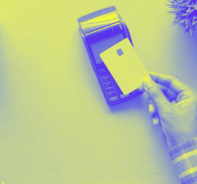Your guide to understanding what is chargeback fraud – and why you need to protect your business.
A chargeback happens when a purchase is reversed, and a consumer gets their money back because of a dispute initiated with their card company. Chargeback frauds are on the rise today and have been increasing by 20% year over year (Expert Market).
Chargebacks were initially intended to instill confidence in debit and credit card security and provide consumers with a security layer of protection. Chargebacks, both legitimate and fraudulent, can be initiated for numerous reasons. A consumer can dispute a purchase on their bill for a variety of causes:
- They don’t recognize the charge on their card
- The customer never received their purchase or they were billed incorrectly
- They feel the product or service they paid for was not as promised
- Their information was stolen and is being used fraudulently
- A merchant’s return policy is unclear, and a customer is not sure how to otherwise initiate a return
Over 30% of chargebacks are for purchases made with stolen credit card information. (Shift Processing). Chargeback frauds have a drastic impact on the business bottom line. A $1 fraud cost the US retailer $3.36 in 2020, meaning merchants with a high volume of transactions can suffer large losses if unable to prevent this fraud (LexisNexis).
6 Ways to Protect Your Business from Chargeback Fraud
Table of Contents
- 6 Ways to Protect Your Business from Chargeback Fraud
- Chargeback Fraud Is on the Rise
- Different Types of Chargebacks
- The Five Fraud Challenges Online Marketplaces Must Address In 2024
- Six Ways to Protect Your Business From Chargeback Fraud
- Chargeback Fraud Is a Serious Concern
- Rapyd Offers Built-In Payment Fraud Protection with Advanced Features
Chargeback Fraud Is on the Rise
A concern for businesses is the fact that chargebacks have been increasing by 20% year over year. Mercator Advisory Group predicts that the volume of chargeback frauds will increase to 33 million in 2022.
Chargeback fraud is a serious concern for businesses, and the impacts should not be taken lightly. Not only can a business lose the money on products and services sold, but there are also fees associated with chargebacks that end up being the merchant’s responsibility. Additionally, if a merchant is hit with too many chargebacks, they could even end up losing the ability to process card transactions altogether.
Here are some of the most the common types of chargeback frauds and ways that you can protect your business and prevent revenue loss.
Different Types of Chargebacks
Criminal Fraud Chargeback
This kind of credit card fraud occurs when criminals make an unauthorized purchase using the consumer’s stolen credit card, stolen credit card number, or hacked account information. The fraud often comes to light much later when the actual cardholder reviews the transaction statement and identifies the transaction as illegitimate. More than 1-10% of frauds occur due to chargeback scams (Shuftipro). Chargeback scams can be prevented by looking for red flags in your consumers’ behavior.
For example, the difference in ‘ship to’ and ‘bill to’ address, and unusual purchasing behavior are some red flags to watch out for. There are also organized retail rings that order large quantities of products to resell, request a chargeback, and sell it at nearly 100% profit (PaySimple). If needed, you must verify the orders with the actual cardholder to prevent chargeback frauds. You should also ensure that the best security practices are followed while accepting credit card payments online.
Merchant Error Chargeback
A merchant error chargeback occurs when the consumer doesn’t get what they paid for or when the merchant mistakenly charges the consumer with an incorrect, duplicate, or unauthorized transaction. Other causes for this error include incorrect billing descriptions, transaction processing errors, inaccurate product descriptions, and unclear return policies.
Research reveals that merchant errors are responsible for 20-40% of chargebacks (Chargebacks911). You can leverage the merchant chargeback protection offered by your payment provider to get an opportunity to resolve the consumer’s complaint before they demand a chargeback. You must also analyze the root cause of chargeback and address the issues to eliminate merchant errors and prevent future chargebacks and revenue loss.
Friendly Fraud Chargeback
A friendly chargeback occurs when the consumer purchases a product or service, receives it from the merchant, but files for a chargeback. This is often because of an expectation mismatch. Consumers can ask for a chargeback if the product does not match its description, they do not recognize a charge on their statement because the merchant used a different name, or if a family member made the purchase without the cardholder’s knowledge.
Intentional Consumer Fraud Chargeback
A small number of consumers also indulge in fraudulent chargebacks to avoid paying for the goods and services they purchased. This kind of fraud is hard to detect and refute as the customers are legitimate, and there is a legitimate transaction record available as evidence.
Six Ways to Protect Your Business From Chargeback Fraud
Here are six ways to be proactive about avoiding chargeback frauds:
1. Keep Up-to-Date on New Chargeback Codes
Did you know that chargeback reason codes are not static or permanent? In 2022, each card network has a new set of chargeback reason codes, or the categories available to indicate the reason for a consumer dispute when they are requesting a refund or chargeback.
It is critical that merchants stay up to date on new chargeback reason codes so that they can properly advocate for themselves if something is amiss. If a consumer indicates that the charge was fraudulent, for instance, but a merchant has evidence that proves otherwise, they can dispute the consumer’s dispute and potentially overturn the chargeback. Additionally, keeping abreast of chargeback reason codes can help you understand why consumers are requesting chargebacks in case there is a recurring theme that you can find a solution for.
2. Maintain Precise Documentation of All Card-Based Transactions
Some of the best evidence when disputing chargebacks can come in the form of signatures and receipts. Keeping meticulous records of transactions can help you in the long run, especially if you have physical records like these. However, with the growing volume of ecommerce-based transactions, having physical documentation or signatures is not always feasible. In this case, be sure to keep records or utilize a technology solution that can keep records around card-based transactions, to include the date and time of the transaction or IP address the transaction came from.
3. Leverage Technology Designed to Protect You from Chargeback Frauds
Authentication methods like 3D Secure were created by Visa and Mastercard in an effort to add more security to the card acquisition process and to protect merchants from chargeback liability. This authentication protocol instead shifts the liability to the card issuer, as opposed to chargebacks landing on the merchant for responsibility.
Additionally, when businesses invest in fraud protection technology, it can help them identify chargeback fraud opportunities before they occur, by identifying high-risk transactions and allowing the business to create custom rules for transactions it will and won’t accept, whether it’s concern over specific IP addresses or blocked countries. Having an always-on fraud protection partner can seriously reduce your risk of disputes stemming from fraud overall.
4. Ensure Your Team Is Well-Trained on the Guidelines Issued by Your Payment Processor
When your team understands payment processor compliance protocol, they will be better prepared to spot suspect activity as it is happening. Training your team in transactions both when a card is present and when a card is not present can stop fraud before it’s in motion, which is a merchant’s best line of defense. Secure payment processes exist to protect businesses. Regularly train your team on compliance in order to better identify risk when they see it.
5. Stay Consistent with Your Payment Descriptions and Merchant Name
If a consumer doesn’t recognize the charge on their card, a dispute may be their first turn. It can cause panic for consumers when they don’t recognize a name or recall making a purchase, sending them into damage control mode in the event that their cards or identity were stolen. Merchants can mitigate this simply by ensuring that the company name that shows up on a charge matches the company name that the consumer recognizes. This is an easy fix that could save your business from serious chargeback hassles and costs in the long run.
6. Respond to Customer Service Issues Promptly
81% of consumers initiating disputes admit that they do this out of convenience, making it imperative that merchants make it just as convenient for consumers to get their issues resolved directly with the merchant (The PayPers). With “friendly fraud” rates expected to top $130B in damages from the last year, it’s critical that merchants take every possible preventive measure to eliminate fraud opportunities before they happen (Ecommerce Fraud Statistics). One way to do this is to provide 24/7/365 customer support, allowing consumers to reach out to your business directly to settle concerns over product or service quality, delivery delays, or return policies that they may otherwise be unclear about.
Not all businesses may be able to provide this level of support available to their customers, however. In these cases, it is critical that merchants and their teams respond quickly to all customer service queries and concerns. Making return policies clear on the business website, along with answers to other frequently asked questions, is another good way to circumvent confusion or concern around purchases.
Chargeback Fraud Is a Serious Concern
In today’s digital marketplace, an increasing number of transactions are occurring without cards present, making chargeback fraud risks even more of a concern. In 2019, businesses lost 4.4% of their revenue to chargebacks, making a sizable impact on their bottom line (Midigator)
With merchants only receiving dispute resolution judgments to their advantage 56% of the time, it is more important than ever that they take action into their own hands by preventing fraud from the start (Midigator). Whether protection comes through protocol process training, building more open lines of communication with consumers, or investing in fraud protection technology, merchants need to be aware of this growing threat to their bottom line.
Rapyd Offers Built-In Payment Fraud Protection with Advanced Features
Stop chargeback fraud from hurting your business by using the multifaceted fraud protection available through Rapyd Collect that comes complete with Rapyd Protect, you can have greater safety from the risk of fraud, no matter where you do business or what payment methods you accept.
- Fraud coverage in 100+ countries
- Fraud protection for hundreds of payment methods
- Covering 2 million global access points
Rapyd Collect also lets you accept alternative payments methods that have very little chargeback risk such as bank transfers, cash vouchers and more.
Sources:
What Is Chargeback Fraud? Criminal Fraud vs. Friendly Fraud. Kount, 15 April 2021, https://kount.com/blog/chargeback-fraud-what-are-chargebacks-and-how-can-businesses-prevent-them/.
What are chargeback frauds and what do they mean for businesses?. 22 May. 2020, https://shuftipro.com/blog/what-are-chargeback-frauds-and-what-do-they-mean-for-businesses/.
How Chargeback and Fraud Operations Work.17 Aug. 2021, https://www.merchantfraudjournal.com/chargeback-operations-fraud-how-work/.
Eliminating Merchant Error Chargebacks. 26 Aug. 2021, https://www.chargebackgurus.com/blog/merchant-error-chargebacks.
The Top 15 Merchant Errors That Trigger Chargebacks. 25 Mar. 2021, https://chargebacks911.com/merchant-error/
What is Chargeback Fraud, and How Can You Prevent It? | PaySimple. https://paysimple.com/blog/what-is-chargeback-fraud-and-how-can-you-prevent-it/
Friendly Chargeback Fraud: What It Is and How to Stop It. 10 Sept. 2021, https://www.merchantfraudjournal.com/friendly-fraud-how-stop/
Friendly Fraud. https://fraud.net/d/friendly-fraud/
What Is Chargeback Fraud? Criminal Fraud vs. Friendly Fraud – Kount.” 15 Apr. 2021, https://kount.com/blog/chargeback-fraud-what-are-chargebacks-and-how-can-businesses-prevent-them/
Chargeback Categories.https://chargebacks.com/what-are-the-two-main-chargeback-categories-and-what-is-the-difference-between-the-two/.
What is Friendly Fraud and How Can I prevent it in 2021?. 30 Jul. 2021, https://www.chargebackgurus.com/blog/friendly-fraud-its-a-family-affair
Business Insider. (2020, 3 3). “Friendly Fraud” Expected to Top 130 Billion in 2020–Chargebacks Hurting Merchants and Consumers. Markets Insider. https://markets.businessinsider.com/news/stocks/friendly-fraud-expected-to-top-130-billion-in-2020-chargebacks-hurting-merchants-and-consumers-1028959185#:~:text=to%20BI%20Prime-,%22Friendly%20Fraud%22%20Expected%20to%20Top%20130%20Billion%20in%202020%2D%2
Chargeback Gurus. (2020, 12 2). Chargeback Reason Codes by Network – 2021 Guide. Chargeback Gurus. https://www.chargebackgurus.com/blog/a-definitive-guide-to-chargeback-reason-codes-by-card-network
Chargebacks911. (2019, 2 8). Chargeback Stats. Chargebacks911. https://chargebacks911.com/chargeback-stats/
Ecommerce Fraud Statistics. Vukova, Christina, “61+ Ecommerce Fraud Statistics to Help You Say Safe in 2020,” Review 42, December 13, 2019, review42.com/ecommerce-fraud-statistics/
Expert Market. Chargeback Fraud Infographics https://www.starmicronics.com/blog/avoid-dispute-chargebacks/
FinTech Magazine. (2020, 12 10). Merchants report rise in friendly fraud from mobile payments. FinTech Magazine. https://www.fintechmagazine.com/fraud-and-cybersecurity/merchants-report-rise-friendly-frauhttps://www.fintechmagazine.com/fraud-and-cybersecurity/merchants-report-rise-friendly-fraud-mobile-paymentsd-mobile-payments
Juniper Research. (2020, Unknown Unknown). Online Payment Fraud Whitepaper. Experian. http://www.experian.com/assets/decision-analytics/white-papers/juniper-research-online-payment-fraud-wp-2016.pdf
LexisNexis.(2020). 11th annual LexisNexis Risk Solutions 2020 True Cost of Fraud Study: e-Commerce/Retail Edition. https://risk.lexisnexis.com/about-us/press-room/press-release/20200721-tcof-retail-study
MerchantScout. (Unknown). What are the best ways to prevent chargebacks? MerchantScout. https://www.merchantscout.com/how-to-prevent-chargebacks
Midigator. (2020, Unknown Unknown). ANNUAL CHARGEBACK REPORT & STATISTICS. Midigator. https://midigator.com/chargeback-report-statistics/
Payment Depot. (2020, September 8). How to Fight and Prevent Credit Card Chargebacks in Your Small Business. Payment Depot. https://paymentdepot.com/blog/fight-prevent-credit-card-chargebacks-small-business/
The PayPers. European cardholders in precarious position because of friendly fraud. https://thepaypers.com/expert-opinion/european-cardholders-in-precarious-position-because-of-friendly-fraud–765300
Shift Processing. (2021) Chargeback Statistics. https://shiftprocessing.com/chargeback-statistics/#:~:text=30%25%20of%20chargebacks%20are%20from,Terminals%20help%20offset%20fraud%20risk.
Subscribe Via Email
Thank You!
You’ve Been Subscribed.




